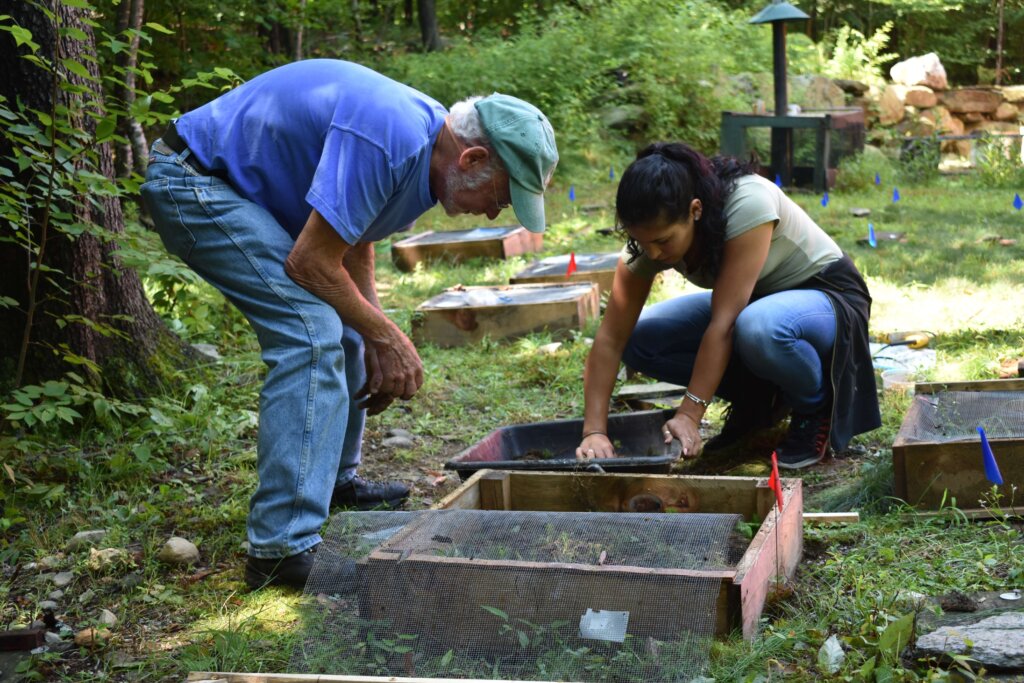Two Elms biology majors are assisting with a research study on abnormal behavior in Eastern red-backed salamanders. Their findings could impact the way conservationists address deforestation.

Eco-puzzles in Western Mass
Take a walk in the woods virtually anywhere in New England, and chances are you will pass by hundreds, if not thousands, of Eastern red-backed salamanders, right underfoot. These tiny creatures — which, fully grown, max out at two to five inches in length — spend their entire lives roaming a single square meter of “humis,” the damp, nutrient-rich soil that comprises the forest floor.
While you might not think twice about encountering Plethodon cinereus in the wild, these tiny salamanders are actually key players in forest ecosystems from northern Tennessee to southern Ontario. And they’re up to something very strange in western Massachusetts.
When Doug Fraser, Ph.D., moved to Chesterfield, MA, he began clearing land to build a new home. He noticed that Eastern red-backed salamanders were popping up all over the grassy areas of his backyard. This behavior is highly unusual, since the salamanders risk life and limb every time they leave the protection of the forest undergrowth.

Shrews, voles, and other small mammals are the natural predators of the Eastern red-backed salamander, and can spot them more quickly out in the open. If the salamanders continue to behave erratically and desert their natural habitat, it has the potential to impact the entire food chain. Investigating this idea is part of an ongoing series of experiments for Dr. Fraser, a professor emeritus at Siena College, who has researched behavioral responses, predation threats, and ecosystem changes for more than 40 years.
Interdisciplinary Collaboration
Interdisciplinary collaboration is a core value at Elms College, and it often leads to unexpected academic opportunities for students. Elms biology professor Nina Theis, Ph.D., met Dr. Fraser on an international research trip to Trinidad in the summer of 2018. After learning about his work and close proximity to Elms, she arranged to take her biology classes to the property once per semester. For students interested in gaining long-term field experience, Dr. Theis worked with Dr. Fraser to establish internship opportunities for students.
For Nick doCarmo ’19 and Carissa Colby ’18, BMS ’19, partnering with Dr. Fraser has been illuminating.
“We have great faculty for biology who really nail down the basics for you,” said Nick. “Having that base knowledge helped me transition into working a live experiment.”

After making a couple dozen trips to the property over the past year,Nick and Carissa developed a working theory suggesting that the salamanders leave the forest in search of food. While insects can burrow deep into the porous soil of the woods to avoid their predators, they have a much harder time maneuvering through the dense, hard-packed soil of clear cut surfaces.
To confirm their hypothesis, the team designed an experiment to analyze the concentration of insects in the forest loam versus the clear cut grass. They sampled three cubic inches of soil from each area.
“We discovered that there are about three times as many springtails — the salamanders’ favorite food source — out here in the grass,” said Carissa.
That finding amounts to roughly 30,000 microscopic meals for the Eastern red-backs, packed into an area of soil slightly smaller than a Rubik’s Cube. In other words, the salamanders put everything on the line in exchange for an all-you-can-eat buffet.
“They’re really unassuming creatures. But, they represent a huge part of the energy cycle, and the cycle of nutrients, throughout the forest system.”
Nick doCarmo ’19
Armed with this knowledge, the team began cataloguing differences in weight gain among the salamander population. Using a collection of 20 wire-mesh boxes scattered throughout the forest and clear cut, the team isolated individual salamanders in each box, forcing their subjects to dine on only one type of soil. After a period of 30 days, the team would open the boxes, sift through the dirt to find the salamanders, and carefully weigh them.
“They’re really unassuming creatures,” said Nick, who plans on joining a state wildlife agency after graduating in December. “But, they represent a huge part of the energy cycle, and the cycle of nutrients, throughout the forest system.”

Harbingers of Ecological Threats
Nick and Carissa’s research has bearing on larger discussions about woodland ecology. Dr. Fraser’s property (half forest, half clearing) is a microcosm, a miniature snapshot of heavily wooded land facing encroaching deforestation. In the context of environmental conservation, studying what happens at the micro-level can teach us about the macro-level. For example, a recent study by the University of Missouri-Columbia found that the number of salamanders in a forested area determines how quickly the land can recover from logging activity.
While the experiment is still in the data-collection phase, Nick and Carissa both found their collaboration with Dr. Fraser to be incredibly beneficial. Carissa, who is in the process of applying to veterinary schools for the upcoming application cycle, had the chance to present the team’s preliminary findings at the Northeast Natural History Conference.
“I’m able to relay information so people can understand it at multiple levels,” she said. “Working with Doug has been really helpful in a lot of areas.”
Nick sees his fieldwork as the perfect foundational experience for finding a job in environmental science or ecology.
“I like being out in nature, and want to get a job that’s really hands-on,” he said. “If you can run a controlled science experiment, it doesn’t really matter what field it is — those skills will translate.”
This article was published in the Fall 2019 issue of Elms Magazine. Click here for more information about biology programs at Elms. For students considering graduate school, we also offer a master’s of biomedical sciences.